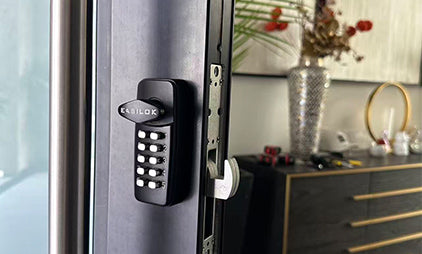
How to Maintain Your Storefront Door Lock for Long-Term Performance
Share
1. Clean the Lock Regularly
Dirt, grease, and debris accumulate inside the keyway and on the keypad surface over time. These contaminants can cause buttons to stick or the key to jam.
Use a mild cleaner and a soft cloth to wipe the exterior weekly. For the internal mechanism, apply a non-oily lock lubricant (avoid WD-40) every three to six months. If your store is located in a dusty or humid environment, increase the cleaning frequency.
2. Inspect for Signs of Wear
Pay attention to small signs of damage—loose screws, worn keys, sticky buttons, or a sluggish latch. These minor issues can turn into full lock failure if ignored.
Perform a quick inspection monthly, especially on high-traffic doors. If you notice resistance or grinding sounds while turning the handle, contact a locksmith immediately.
3. Protect Against Weather Exposure
Storefront doors often face harsh environmental elements—sunlight, rain, humidity, or temperature fluctuations. These can corrode metal components and degrade rubber seals.
Consider installing a small canopy above the door or using a weather-resistant lock model like the Easilok commercial mechanical keypad lock, designed to perform in outdoor conditions.
4. Replace Batteries on Schedule (If Electronic)
If your business uses an electronic keypad lock, create a maintenance reminder to replace the batteries every 6–12 months. Many electronic locks signal low power with flashing lights or sound alerts—never ignore these.
Keep spare batteries on-site to avoid lockouts during business hours.
5. Recalibrate and Reset Access Codes
If multiple employees have access to your storefront, change your keypad access codes every few months. This simple practice prevents unauthorized entry from former staff and helps maintain accountability.
When resetting, always record new codes securely and ensure that only authorized managers have access to them.
6. Schedule Professional Maintenance Annually
Even the best mechanical or keypad locks benefit from a professional inspection. A certified locksmith can clean internal components, replace worn tumblers, and check for alignment between the door and strike plate.
Annual servicing costs far less than an emergency lock replacement.
7. Don’t Force the Lock
If a key or keypad button resists, avoid applying extra pressure—it can worsen the problem. Gently troubleshoot or call a professional. For mechanical locks like the Adams Rite replacement type, forcing the latch can permanently damage the cylinder mechanism.
Conclusion
Lock maintenance isn’t just about extending the product’s life—it’s about protecting your business, staff, and assets. A few minutes of care every month can prevent breakdowns, save money, and ensure that your storefront remains secure and professional.
If you’re using a commercial lock such as the Easilok mechanical keypad series, follow the manufacturer’s care guide and perform routine checks. Consistent attention is the simplest path to lasting performance.

